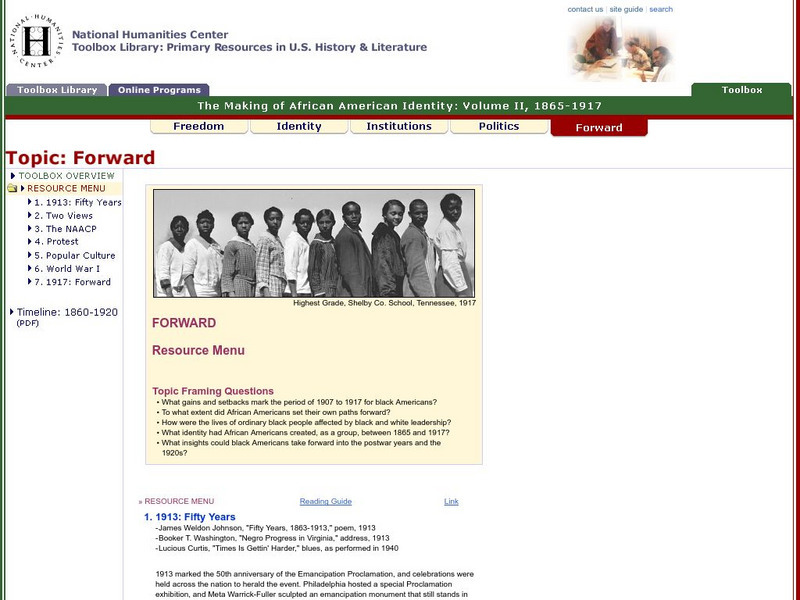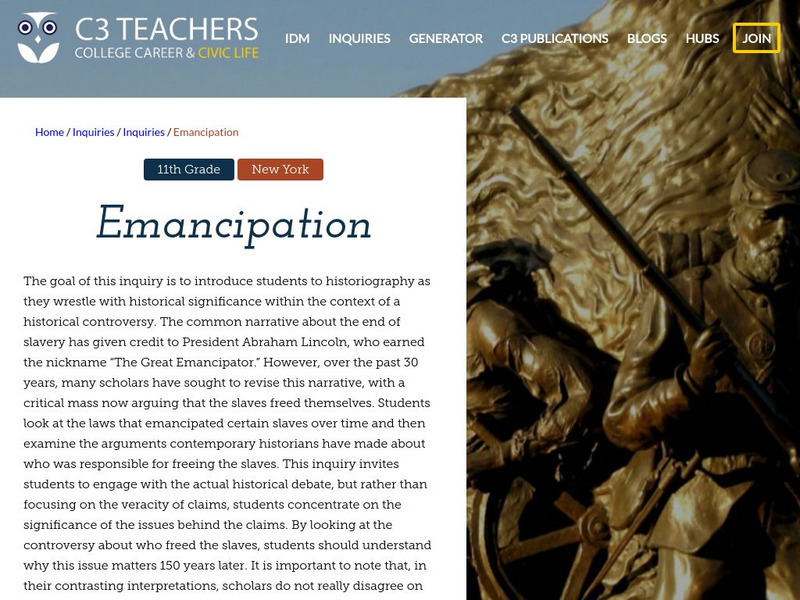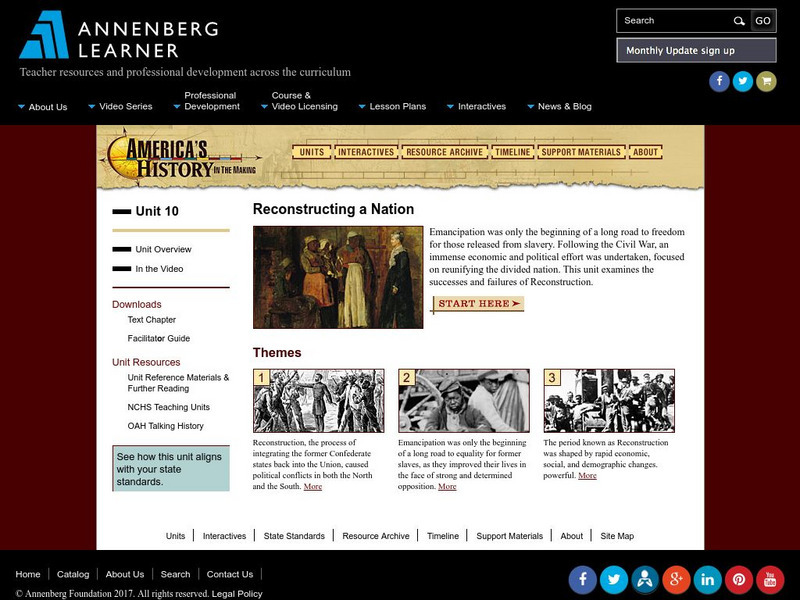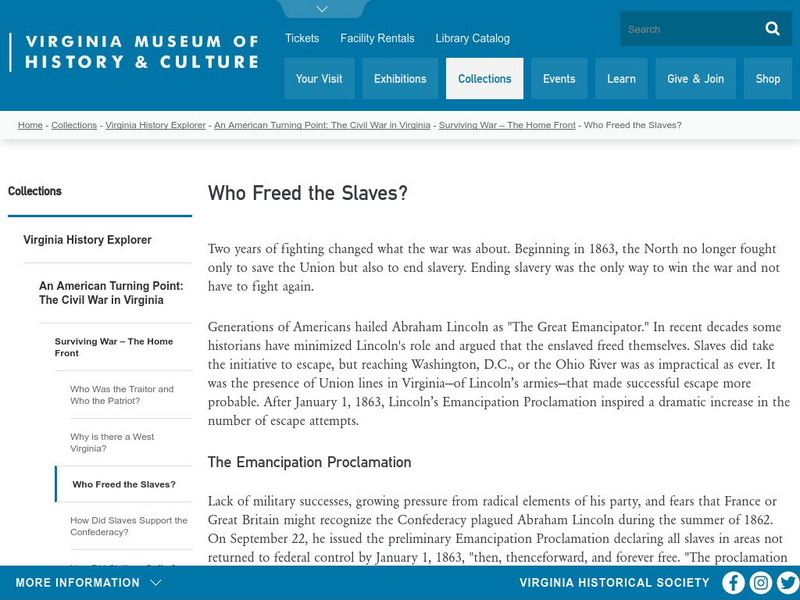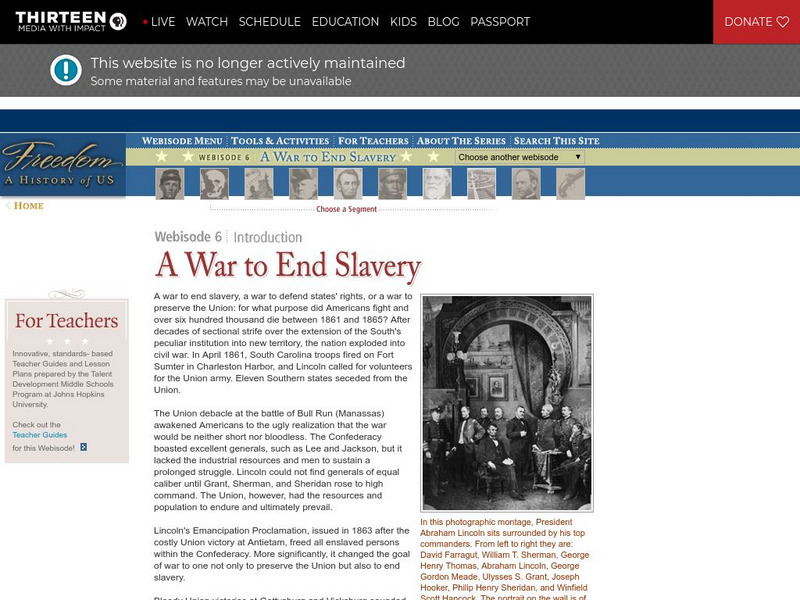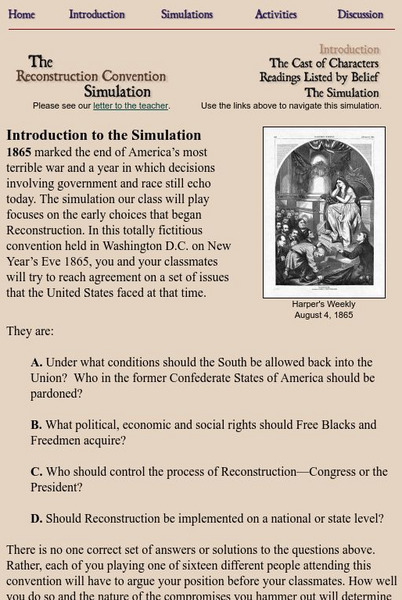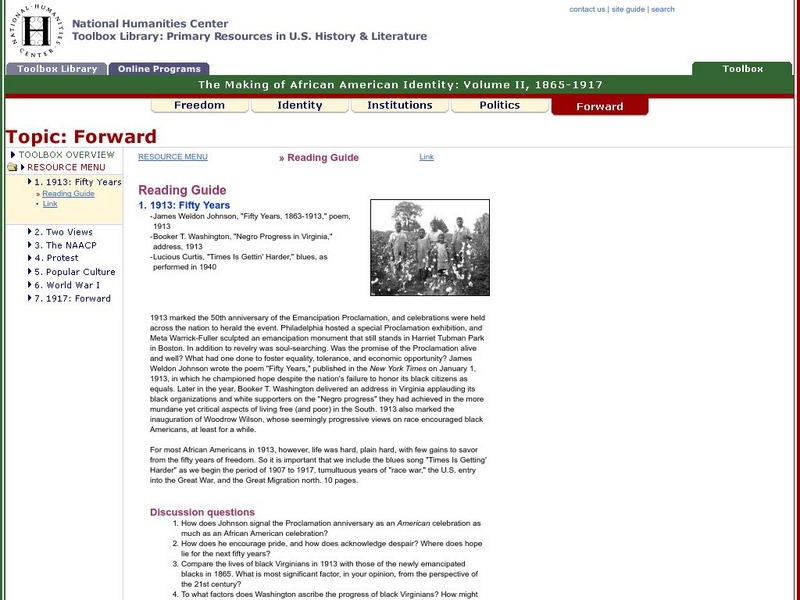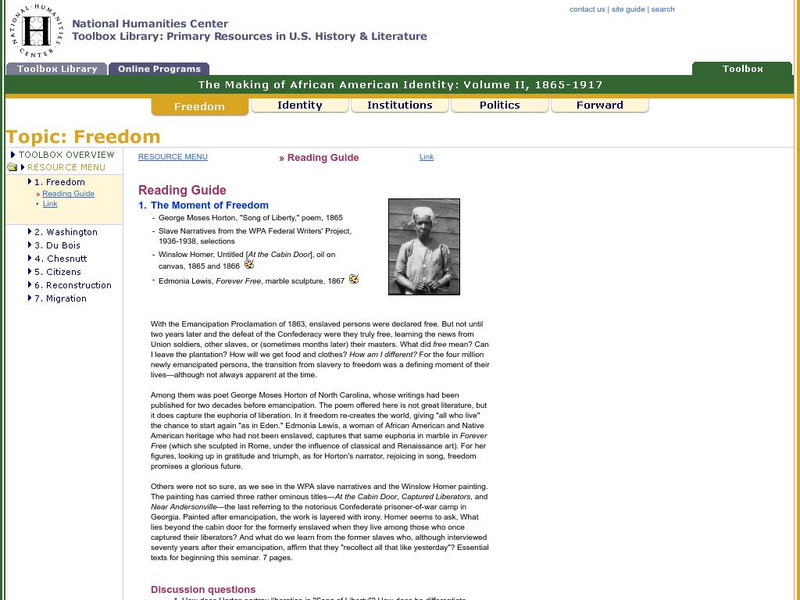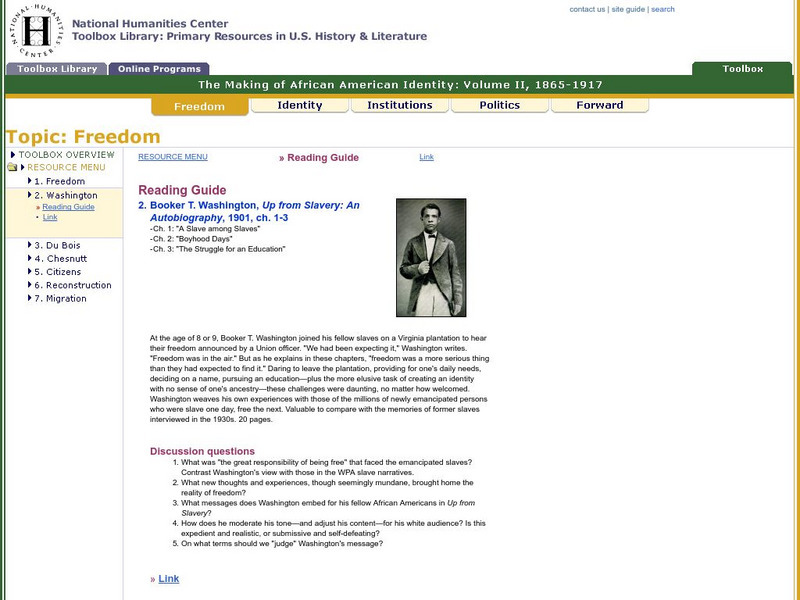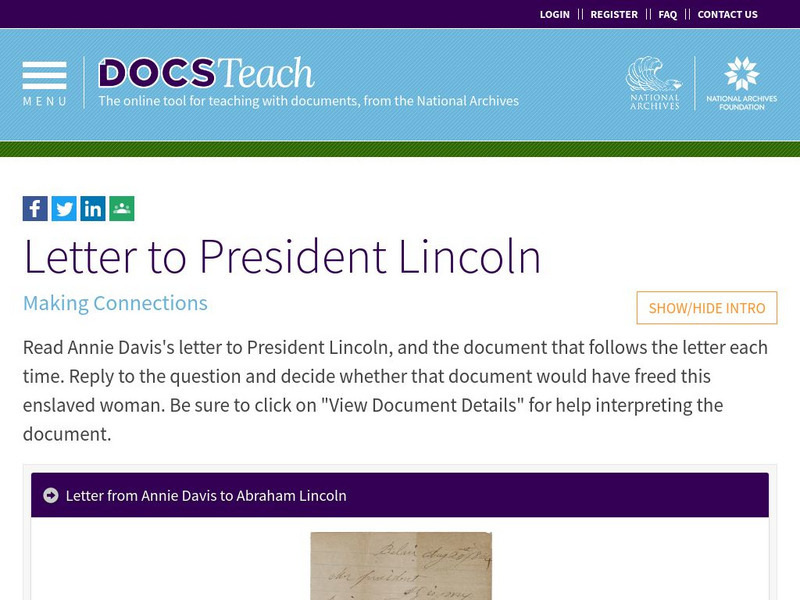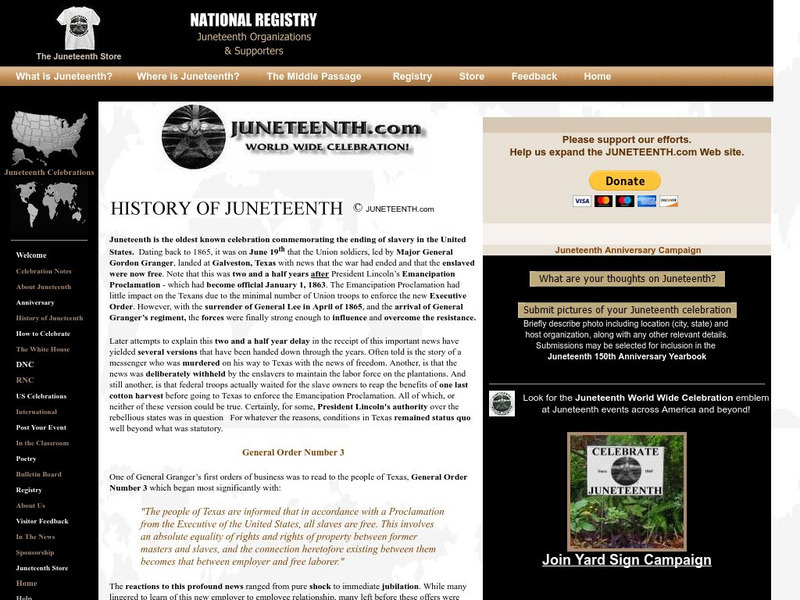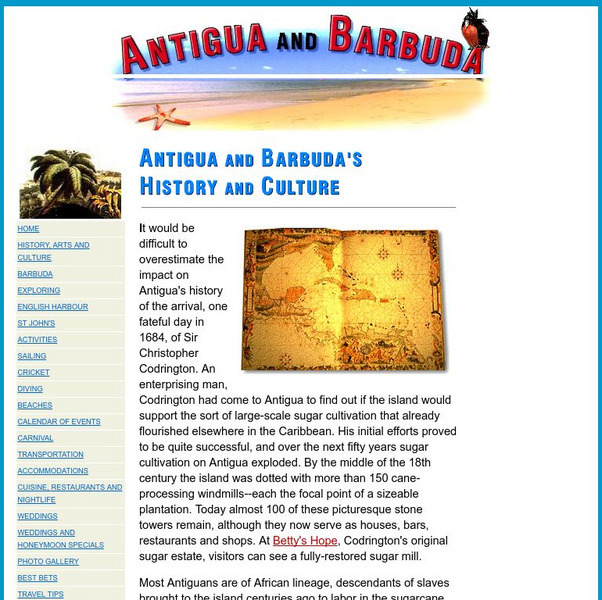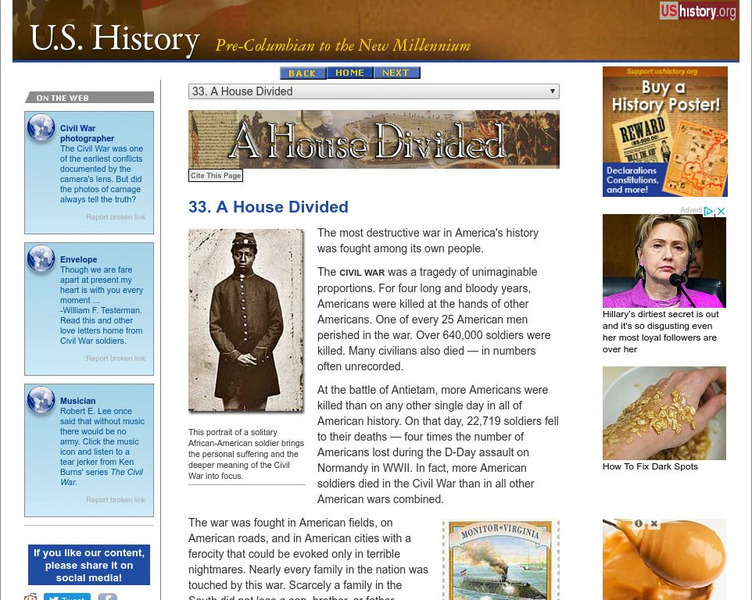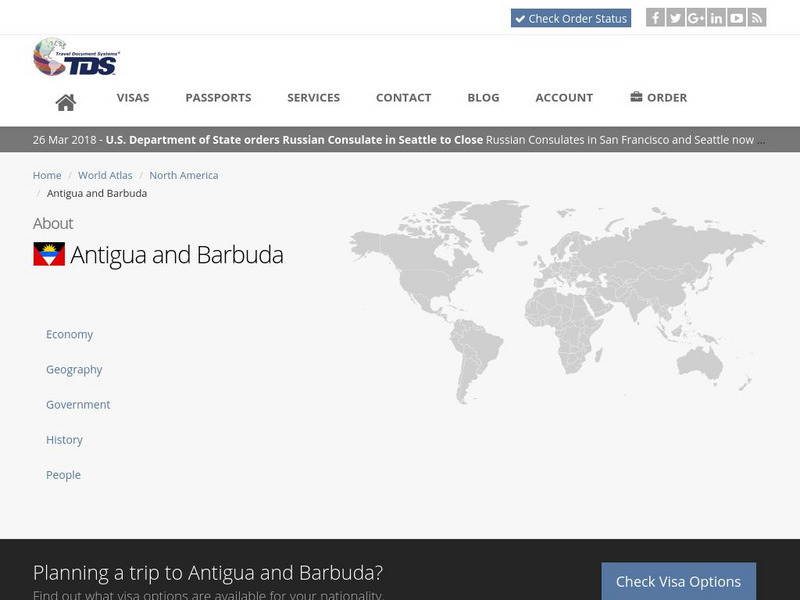National Humanities Center
National Humanities Center: Toolbox Library: Forward, Making of African American Identity: V. 2, 1865 1917
Sixteen texts-historical documents, literary texts, visual images, audio, and video material-that explore the political, social, and cultural state of African Americans at the beginning of the twentieth century.
National Humanities Center
National Humanities Center: Toolbox Library: Freedom, Making of African American Identity: V. 2, 1865 1917
Sixteen primary sources-historical documents, literary texts, visual images, and audio material-that explore African American perceptions of freedom from Emancipation to the early-twentieth century.
Digital History
Digital History: Meaning of Freedom: Black and White Responses to End of Slavery
Confederate defeat and the end of slavery brought far-reaching changes in the lives of all Southerners. The destruction of slavery led inevitably to conflict between blacks seeking to breathe substantive meaning into their freedom by...
C3 Teachers
C3 Teachers: Inquiries: Emancipation
A learning module on the emancipation of African American slaves after the Civil War. It includes several supporting questions accompanied by formative tasks and source materials, followed by a summative performance task. Students will...
Annenberg Foundation
Annenberg Learner: America's History in the Making: Reconstruction
This wonderful unit from Annenberg Media examines Reconstruction through three themes: reintegrating the former Confederate states in to the Union; the freedom of blacks and what that entailed socially and economically; and the economic...
Stanford University
Sheg: Document Based History: Reading Like Historians: Emancipation Proclamation
[Free Registration/Login Required] Students read primary source documents to solve a problem surrounding a historical question. This document-based inquiry lesson plan allows students consider whether Abraham Lincoln freed the slaves, or...
Virginia Historical Society
Virginia Historical Society: The Home Front: Who Freed the Slaves?
Describes how the Emancipation Proclamation of 1863 came into existence, the response from the South, and the impact it had. Three works of art from that period are presented, and the imagery and symbolism explained.
PBS
Wnet: Thirteen: Freedom: A History of Us: A War to End Slavery Webisode 6
A wonderful, interactive site covering many aspects of the Civil War. See photographs, primary sources, and find interesting tidbits about the war. Included are links to lesson plans, teacher guides, resources, activities, and tools.
Harp Week
Education at Harp week.com: The Reconstruction Convention Simulation
A simulation activity where students participate in a convention at the end of the American Civil War that never actually took place. Together they grapple with the issues that faced America in 1865 in dealing with the demise of slavery...
Digital History
Digital History: From Slave Labor to Free Labor
The most difficult task confronting many Southerners during Reconstruction was devising a new system of labor to replace the shattered world of slavery. Learn how plantation owners and freed slaves adapted to this massive shift in the...
Cornell University
Cornell University: Library: I Will Be Heard: The 13th Amendment
Read the text of the 13th Amendment, adopted in January, 1865, even before the end of the Civil War, which ended slavery in the United States. Click on the image to see a larger picture of the document itself.
National Humanities Center
National Humanities Center: Toolbox Library: 1913: Fifty Years, Making of African American Identity: V. 2
A poem, an address, and a blues song that express black life in the first fifty years after the Emancipation Proclamation. The texts examine whether the true meaning of the proclamation carried forward to the lives African Americans.
National Humanities Center
National Humanities Center: Toolbox Library: The Moment of Freedom: Making African American Identity
For the four million newly emancipated persons, the transition from slavery to freedom was a defining moment of their lives?although not always apparent at the time. This resource provides texts that explore what freedom meant to African...
National Humanities Center
National Humanities Center: Toolbox Library: Booker T. Washington, Making of African American Identity: V. 2
A summary and questions related to an autobiography in which Booker T. Washington describes his early experience of freedom. A link to this full text is provided here as well.
National Humanities Center
National Humanities Center: Teacher Serve: The Demise of Slavery
In this essay, J. William Harris, Professor of History at the University of New Hampshire, explains the developments that brought about the demise of slavery.
US National Archives
Our Documents: Emancipation Proclamation (1863)
Image of handwritten copy of Lincoln's Emancipation Proclamation, accompanied by an explanation of the speech's purpose, impact, and role in American history.
Other
Afgen.com: Address to the Colored People
This page from Afgen.com contains the address delivered to the colored people at Galesburg, Illinois, 1867 by Robert G. Ingersoll. It emphasizes the rights of blacks as a result of the Civil War and Ingersoll encourages African-Americans...
US National Archives
Docsteach: Letter to President Abraham Lincoln From Annie Davis
Students will study a letter from Annie Davis, a woman who was enslaved in Maryland and wrote a letter to President Abraham Lincoln during the Civil War to find out if 'we are free.' The students will decide if she received her freedom...
Other
Juneteenth.com: History of Juneteenth
Juneteenth.com discusses what Juneteenth is, its history, and its celebration. Content includes a look at why June 19, 1865, signifies the end of slavery in America, as opposed to Lincoln's Emancipation Proclamation of January 1, 1863.
InterKnowledge Corp.
Geographia: Antigua and Barbuda's History and Culture
Read this interesting account of the history of Antigua and Barbuda detailing English development of sugar plantations and sugar mills, and the early emancipation of the slaves on the plantations.
Texas State Library and Archives Commission
Texas State Library and Archives Commission: The 1860s: The Civil War and the End of Slavery
What is the origin of the Texas holiday Juneteenth? Here is a brief article on how this day is connected to the Emancipation Proclamation and the freeing of slaves in the South.
Independence Hall Association
U.s. History: A House Divided
A very brief overview of the Civil War, the casualties, and the horrific social and economic effects across the nation. Included is a map that shows when each Southern state seceded from the Uniion.
Travel Document Systems
Tds: Antigua and Barbuda: History
A brief history of Antigua and Barbuda beginning with the earliest inhabitants, the Siboney, and continuing to the elections of 2004. Information is from the U.S. State Dept. Background Notes.


